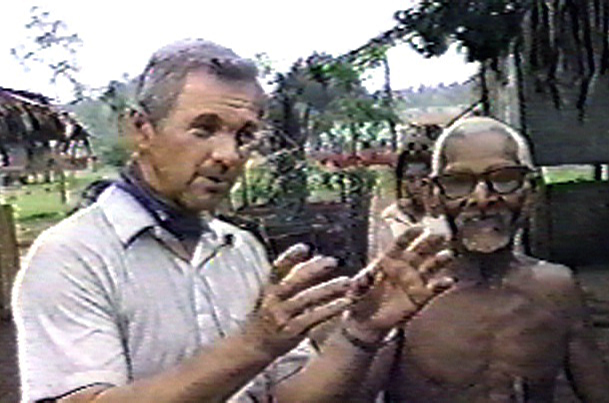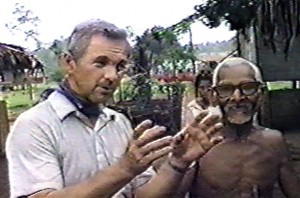Ten years ago today, I was in the Lae International Hotel in Papua New Guinea, preparing for my expedition on Umboi Island while I awaited the small ship that I would board for that island. Today, I received some suggestions and questions about future expeditions and what has been done, in that third world country, regarding searching for the ropen recently.
The suggestions deserve thought, yet how few persons have had the opportunities to see how challenging it can be to search for these flying creatures in Papua New Guinea! Thank you to the man who sent me these comments by email.
Suggestions from a man who is interested in cryptids like the ropen
- I’d first be gathering information from as many sightings as possible, and pinpoint on a map any routes or nesting sites the creature is using on a routine basis.
- The next step would be to set up numerous video cameras triggered to record remotely, with a focus on an open pen area (with adequate time passage to let any scent of man or man-made objects dissipate) where a few pigs (or other potential bait animals) would be left to fend for themselves.
- This procedure would take many months, not weeks, but I’m sure the chance for obtaining viable video footage would be greatly increased.
Responses from Jonathan Whitcomb
#1)
Ten ropen expeditions, in Papua New Guinea, have been led by Americans during the past twenty years. The one led by me and the one led by David Woetzel and Garth Guessman, both in 2004, benefited from the experiences of explorers in the earlier years. The ten expeditions as a whole now deserve attention.
We are grateful for the many sightings of these wonderful flying creatures, and some of the eyewitnesses have reported to us what happened in each of these encounters. Yet even adding the many sightings reported by natives to the missionary James Blume, we still have information on only a tiny fraction of the many thousands of encounters natives must have had over the past few decades. And what are two hundred or so encounters when compared with the size of the tropical rain forests in Papua New Guinea: over 100,000 square miles of jungles. Let’s consider what this means.
One square mile contains over three million square yards. If a ropen nest can be hidden within an area of jungle of 100 square yards, that leaves us with over three billion hiding places, and that’s only within the boundaries of Papua New Guinea. Yet we’re just beginning to see the challenges.
Assuming you had the time to search for those hidden nesting sites, over the necessary centuries it would take, what’s to keep a mother ropen from grabbing her eggs and flying away, seconds before you discover the hidden nest? (How could you hack through all the countless miles of jungle underbrush in silence?)
Please understand, I am not making fun of the suggestions I received today; they can be useful. But we need to know what we’re up against before getting into the positive side. I am indeed smiling as I write this, for we have discovered clues that can make expeditions in these remote jungles far more fruitful than the above numbers would indicate.
I have a few specific ideas about where and how to search for ropens in some areas of Papua New Guinea, but it will take time and more money than my associates and I have ever spent from our personal funds. We would really need help. I will keep those ideas to myself, for the moment.
.
Missionary Jim Blume interviews native eyewitness in Papua New Guinea
.
#2)
The worst human odor—that actually attracts the ropen the most, at least on Umboi Island. A dead body invites the ropen in, so any lesser odors from live humans should be OK.
Leaving live pigs (or other animals) in a pen sounds interesting. A most likely outcome, however, is that local natives will take the pigs for themselves, and that’s assuming the pigs don’t find a way to escape from the pen. Leaving a dead animal out, we’ve tried before, and this is still a good option, albeit it requires more time than we have invested in the past.
#3)
This is an excellent point. It will take much more time than what we have been able to give in the past. Time ties itself to money, in many ways, so it comes back to how much we need financial help with a future expedition.
Additional Thoughts
We have had some undisclosed expeditions, within the past few years, with undisclosed locations. Nevertheless, some of the most promising ideas relate to expeditions right here in the 48 Contiguous states of the USA. This is where most of my expedition attention is now centered.
###
With hundreds of cultures, and languages in Papua New Guinea, a real creature should have different names in different cultures. This is the case, with other names for large nocturnal flying creatures: duwas, kundua, kor, seklobali (also spelled “seklo-bali”), indava, and wawanar.
The Ropen – a Modern Pterosaur
Countless eyewitnesses, in many countries across the planet, have pondered what it was they had seen. But ropens continue to fly overhead, continuing to shock humans who had assumed that all pterosaurs had become extinct millions of years ago.
.




